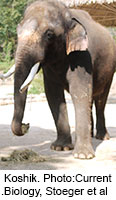
THURSDAY, Nov. 1 (HealthDay News) — Koshik the Asian elephant can “speak” and make himself understood to humans using five words of Korean, according to a new report.
Researchers say Koshik’s ability to imitate the five words provides new insights into the biology and evolution of complex vocal learning, an ability that is critical for human speech.
The five words spoken by the elephant can be readily understood by people who speak Korean. The words include annyong (hello), anja (sit down), aniya (no), nuo (lie down) and choah (good).
Koshik vocalizes with his trunk in his mouth, according to the study in the Nov. 1 issue of the journal Current Biology.
“Human speech basically has two important aspects, pitch and timbre,” study author Angela Stoeger, of the University of Vienna in Austria, said in a journal news release. “Intriguingly, the elephant Koshik is capable of matching both pitch and timbre patterns: He accurately imitates human formants as well as the voice pitch of his trainers. This is remarkable considering the huge size, the long vocal tract and other anatomical differences between an elephant and a human.”
She noted that elephants have a trunk instead of lips and while their large larynx can produce very low-pitched sounds, Koshik’s can exactly match the pitch and characteristics of his human trainers’ voices.
A structural analysis of the elephant’s speech not only showed clear similarities to human voices, but also clear differences to the usual calls of elephants.
Koshik’s unusual vocal ability may stem from when he was a juvenile and spent five years as the only elephant at a South Korean zoo. Humans were his only social contacts during this important period for elephant bonding and development.
“We suggest that Koshik started to adapt his vocalizations to his human companions to strengthen social affiliation, something that is also seen in other vocal-learning species — and in very special cases, also across species,” Stoeger said.
More information
The American Speech-Language-Hearing Association outlines children’s speech and language development.

